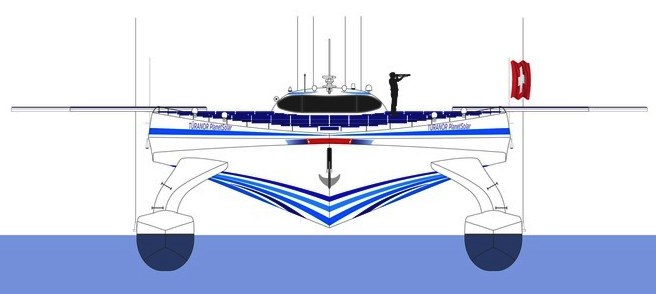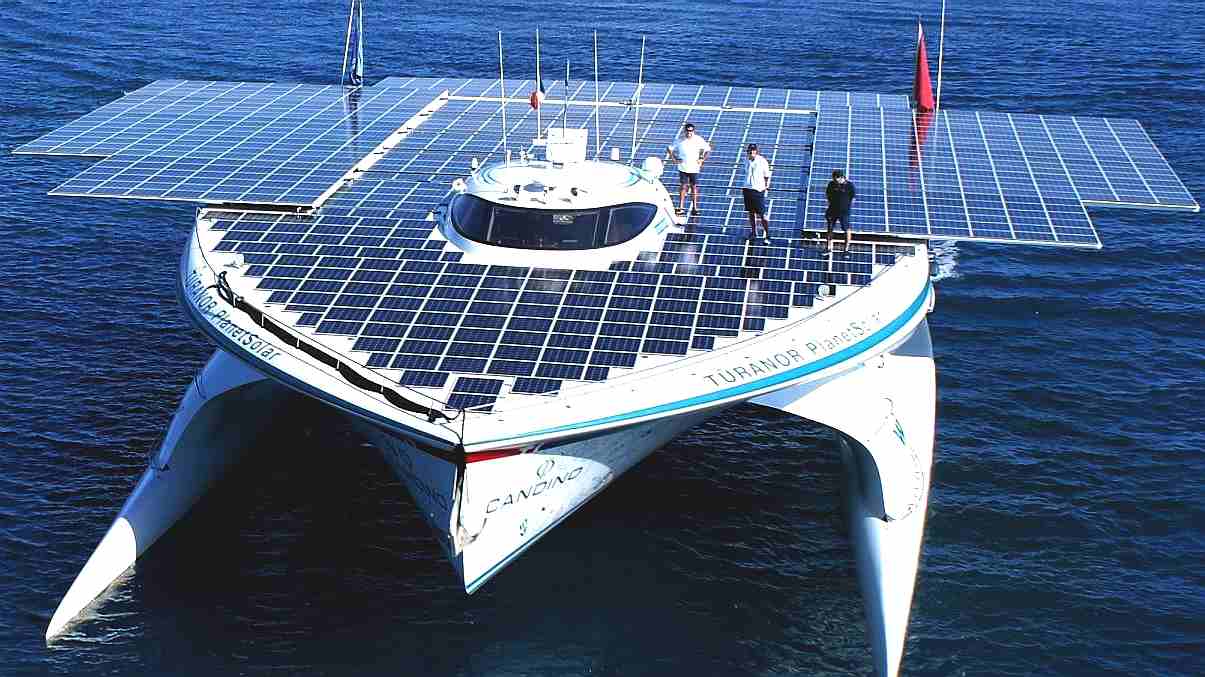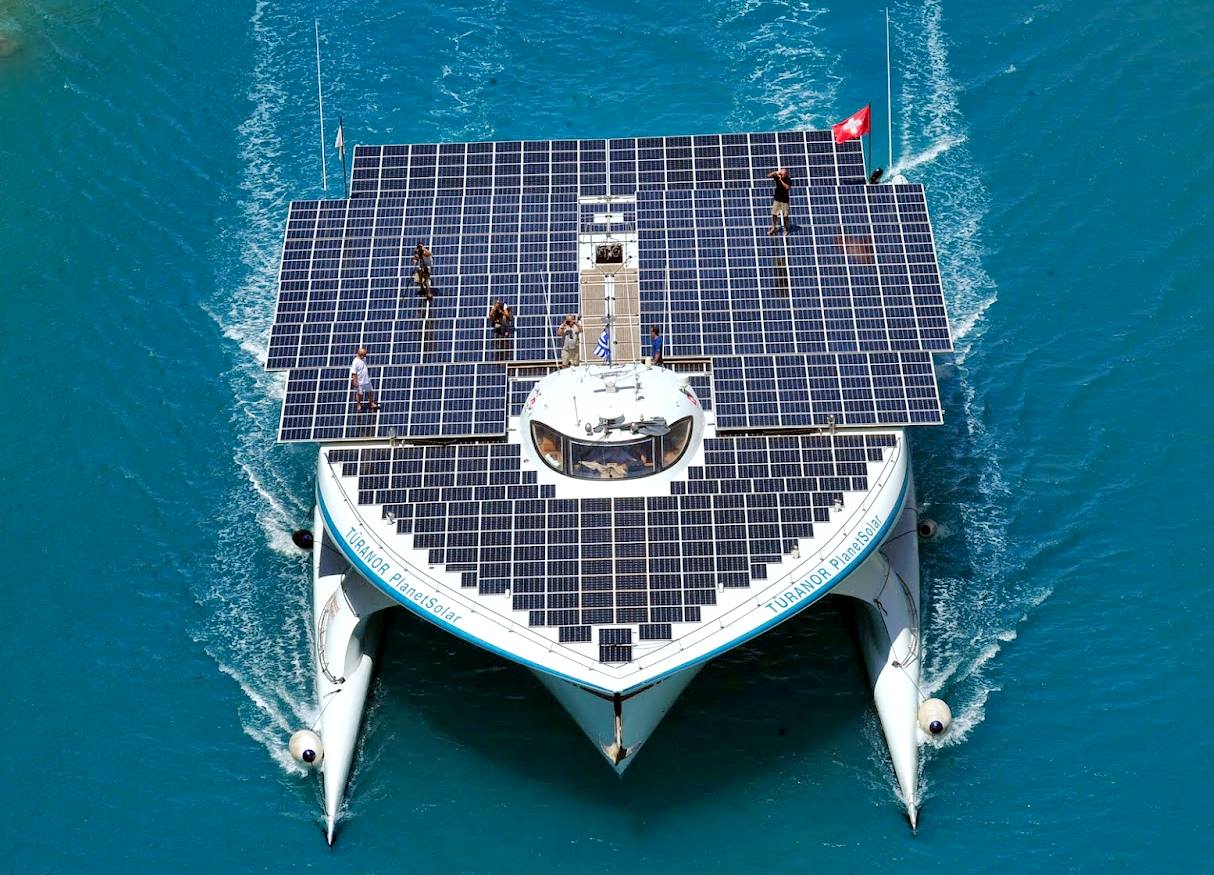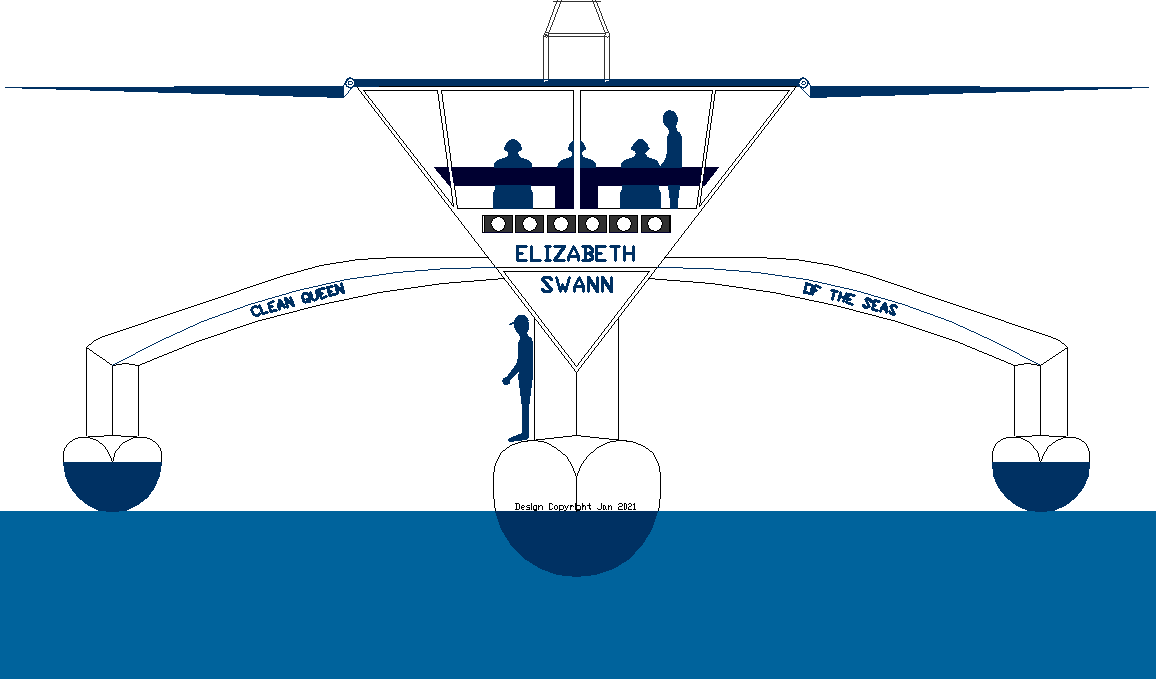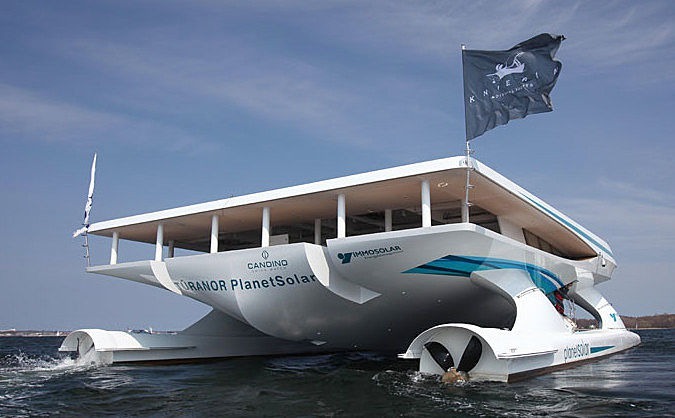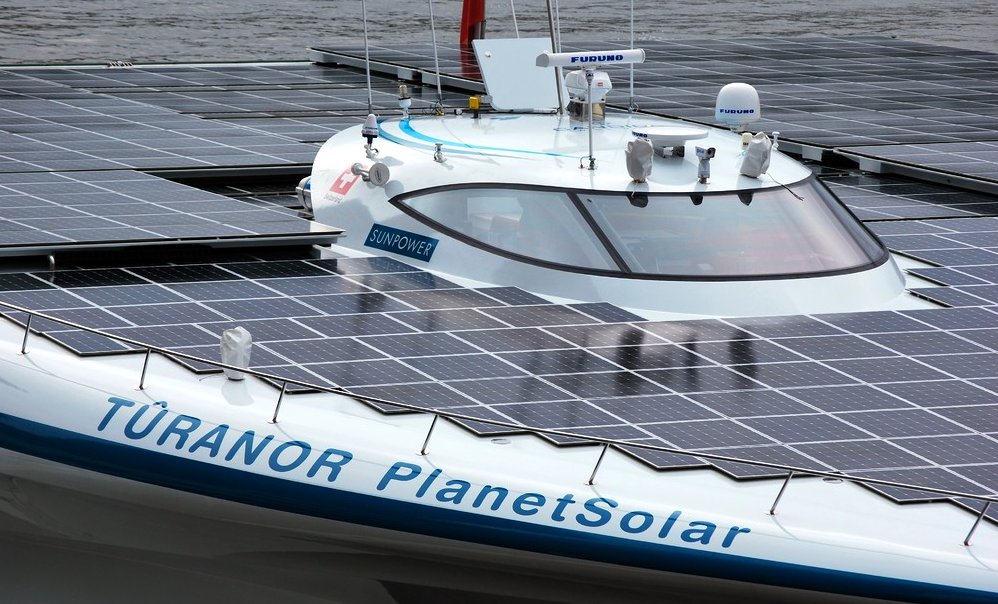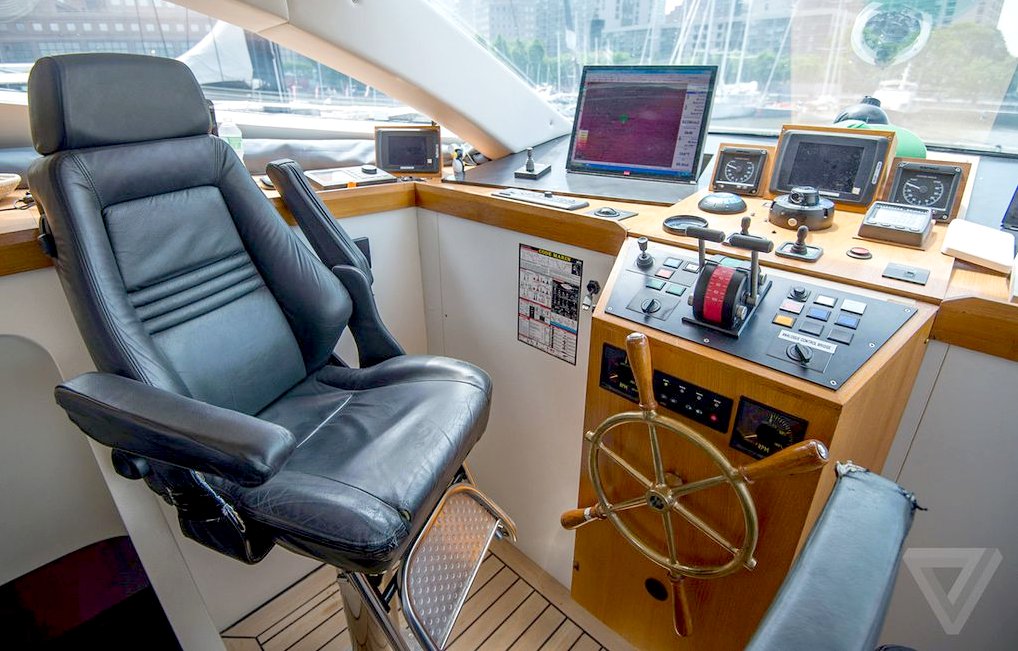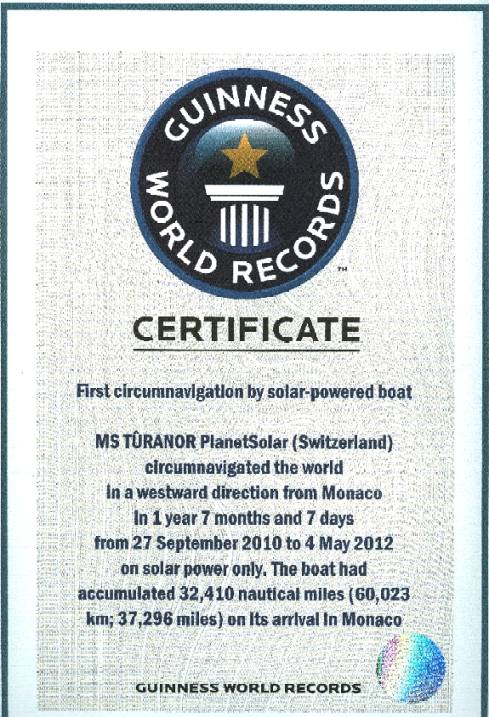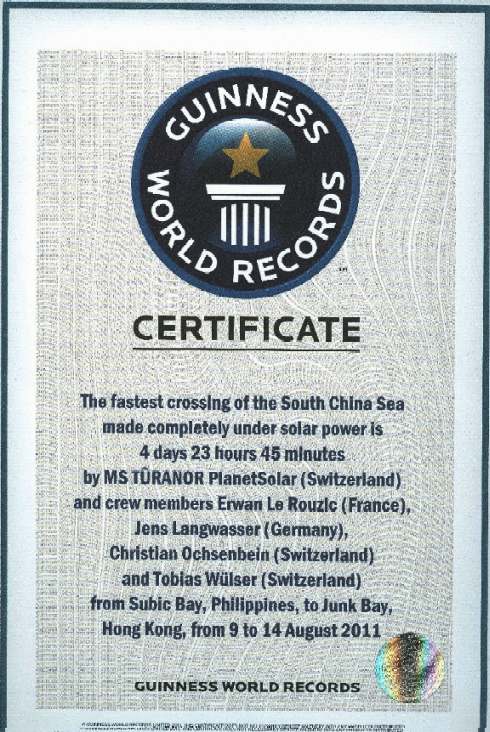|
MS TŪRANOR PLANETSOLAR
Please use our A-Z INDEX to navigate this site or return HOME
|
|||||||||||||||||||||||||||||||||||||||||
On a solar boat speed is all about having a large solar panel area in relation to the mass of the hull. Other considerations are frontal area and hull drag.
MONACO
TO MONACO
The idea was developed by Raphael Domjan and a team, including:
1. The great grandson of Jules Verne; Jean Verne;
2. Jean-Louis Aucouturier, Professor Emeritus at the ENSEIRB Graduate Engineering School - Bordeaux Science and Technology University and President-Founder of the Electric Boats of France (l'Association franēaise pour le bateau électrique - AFBE);
3. Jean-Luc Van Den Heede, Navigator and Record Holder of the solo non-stop westward circumnavigation by sailboat. Ten Cape Horn passages, four around the world sailing tours; two of these tours in the Vendée Globe Race; and
4. Fernand Cuche, Conseiller d'Etat neuchātelois.
THE CREW
A crew of six set out to circumnavigate the globe using only solar power. Captain of the expedition was Frenchman Patrick Marchesseau. Other participants were Christian Ochsenbein (Bern, Switzerland) and Jens Langwasser (Kiel, Germany); as well as project initiator, president and expedition leader Raphaėl Domjan (Neuchatel, Switzerland).
On 27 November 2010 the solar boat reached Miami. A significant stopover was Cancśn, during the United Nations World Climate Conference.
At
the centerline of the world tour, the French Canadian Captain
Erwann Le Rouzic took over in New Caledonia mid May 2011, to assist with
navigation sharing the master's responsibility with
Captain Patrick Marchesseau.
1. fastest crossing of the Atlantic Ocean by solar boat and 2.
longest distance ever covered by a solar
electric vehicle.
GUINNESS BOOK OF WORLD RECORDS: LONGEST JOURNEY
According to the famous record book: "The longest journey by boat on solar power only is 32,410 nautical miles (60,023 km; 37,296 miles), by MS TŪRANOR PlanetSolar (Switzerland), which circumnavigated the world in a westward direction leaving Monaco on 27 September 2010, passing through the Panama Canal and returning to Monaco after 1 year 7 months and 7 days of navigation, on 4 May 2012. MS TŪRANOR PlanetSolar crew included founder and expedition leader Raphaėl Domjan (Switzerland), engineers Christian Ochsenbein (Switzerland), bosun Jens Langwasser (Germany), captains Patrick Marchesseau and Erwan Le Rouzic (both France). Raphaėl Domjan, engineer Christian Ochsenbein and bosun Jens Langwasser followed the circumnavigation from start to finish with breaks in between."
"Other crew members joined the voyage on selected legs of the journey only. The boat left Kiel, Germany, where it had been built, on 31 March 2010 with fully loaded batteries, then headed for Hamburg and on to Monaco for the official start of the world tour on 27 September 27 2010 at 14:41 (departure line in front of the Fermont Hotel). It was a sunny day and the batteries were fully loaded. The PlanetSolar project, initiated by PlanetSolar founder and expedition leader Raphaėl Domjan and ship-owner Immo Ströher, aims to be the first vessel to circumnavigate the globe in a "solar" boat, i.e. one driven by a silent, pollution-free electrical engine powered exclusively by solar energy. The name "TŪRANOR" is derived from J. R. R. Tolkien's Lord of the Rings saga and translates as 'The Power of the Sun'."
"The MS TŪRANOR PlanetSolar, a 31-metre-long and 15-metre-wide catamaran, is powered by a 537 m² (5,780 ft²) photovoltaic solar generator. Batteries are charging during the day and discharging during the night through the propulsion that is composed of 2 semi-submerged propellers driven by 4 engines. Only solar energy is used during the world tour. The MS TŪRANOR PlanetSolar has a diesel backup, but it is sealed. The batteries began to charge as soon as the system was launched on the water in Monaco and can last for approximately 72 hours. The boat is capable of travelling non-stop around the world, but stopovers are made to maintain food supply and undertake public-relations engagements. On the boat showers, lights, fridges etc. are of course powered by solar energy. Only the kitchen operates with gas."
A shame about the kitchen using gas other than hydrogen, but otherwise, a truly amazing achievement.
GUINNESS BOOK OF WORLD RECORDS: COMPLETES WORLD VOYAGE
According
to the famous record book: "MS Tūranor PlanetSolar, the world's largest solar-powered boat, today
(4
May 2012) completed an incredible round-the-world journey which has earned the catamaran and its crew a total of five world records.
PLANETSOLAR SPECIFICATIONS
Turanor PlanetSolar measures 31 m long (35 m with flaps), with a beam of 15 m (23 m with flaps) and has a displacement of 85 tonnes. The catamarans upper surface is covered in 537 m2 of solar panels allowing the vessel to be powered by solar energy alone. On 27 September 2010 the boat left Monaco on the first stage of an attempted circumnavigation.
COMPARE DESIGNS
This is a useful comparison table between the Elizabeth Swann and PlanetSolar based on the published details above. Note the Swann's specification is draft (estimated) and subject to change as the development proceeds, the Planet's spec is actual:
Very different designs, Catamaran Vs Trimaran frontal area comparison, with the Swiss boat having more to push through the air and through the water. The PlanetSolar also has increased wave drag from the central 'V' hull in rough seas as waves slam the undersides. The Swann seeks to avoid as much wave drag as possible by raising the cabin and deck areas higher. The Swann is a longer boat, with a higher speed/length ratio, making it potentially the largest solar boat ever built as @ 18 January 2021. PlanetSolar has no wind turbine to capture additional solar energy, a missed opportunity, but then that is why R&D hails innovation.
Note the unusual propeller design of this boat - surface piercing blades or paddles that create a lot of splash.
TRANSATLANTIC RECORD APRIL 25 - 18 MAY 2013
The previous solar Atlantic record set by MS Tūranor PlanetSolar in November 2010 was bested in 2013, using the same route - from Las Palmas, Gran Canaria, Spain, on April 25, 2013. She sailed across the Atlantic Ocean, traveling at a speed of 5.3 knots before it reached Marigot, St Martin, in the French West Indies on May 18, 2013.
Despite several consecutive days of cloudiness the boat reached its destination in 22 days, 12 hours and 32 minutes - four days shorter than in 2010. PlanetSolar previously held this record with a time of 26 days 19 hr 10 min. See certificate below.
Switzerlands MS Tūranor PlanetSolar, is currently the worlds largest solar boat (Oct 2020).
Having departed Las Palmas, Spain, on April 25, 2013, the solar powered boat sailed 2,867miles (5,310 kilometers) across the Atlantic
Ocean again.
It is difficult to compare the two crossings because they were conducted at very different times of the year. But it is
sure that major improvements over the previous winter - particularly to the propulsion
system - had increased the ships performance, according to Gérard dAboville, Captain of the MS Tūranor PlanetSolar.
Guinness Book of World Records, certificates for transatlantic and circumnavigation 2010 and 2012 by a solar powered boat.
Guinness Book of World Records, certificates for the fastest crossing of the South China Sea and the world's largest solar powered boat @ 31 meters long x 15 meters wide and 85 tonnes.
LINKS & REFERENCE
https://www.guinnessworldrecords.com/news/2012/5/largest-solar-powered-boat-completes-around-the-world-voyage-41497/
Please use our A-Z INDEX to navigate this site
|
|||||||||||||||||||||||||||||||||||||||||
|
This website is Copyright © 2021 Jameson Hunter Ltd
|
